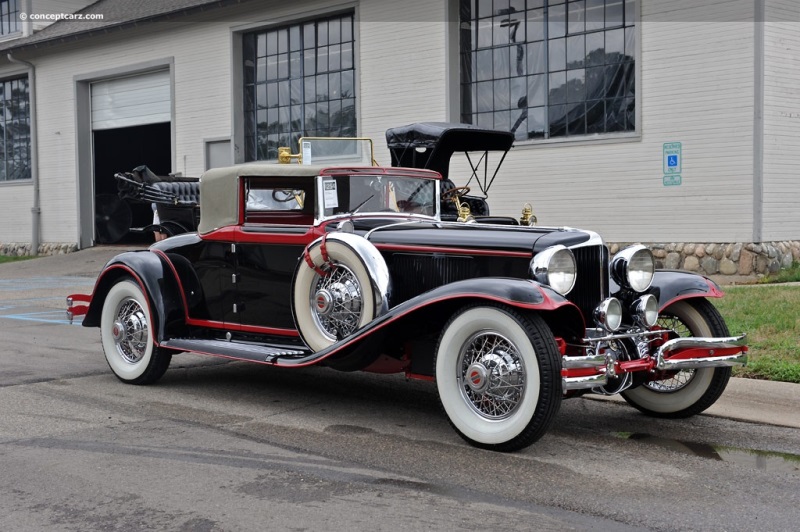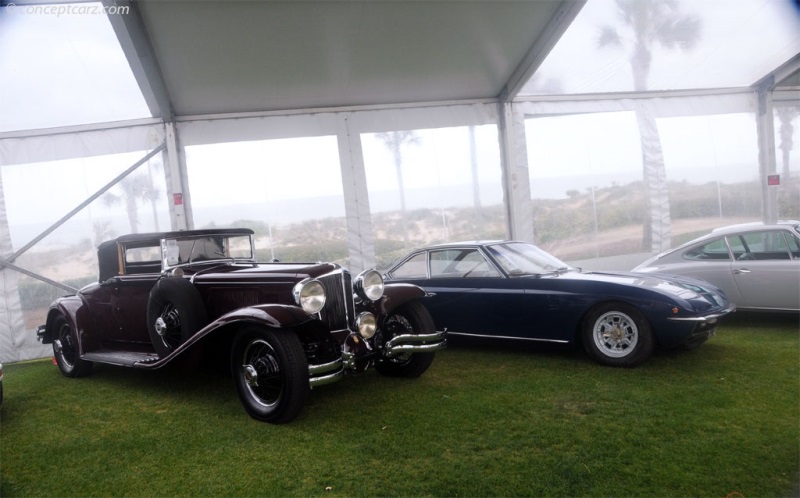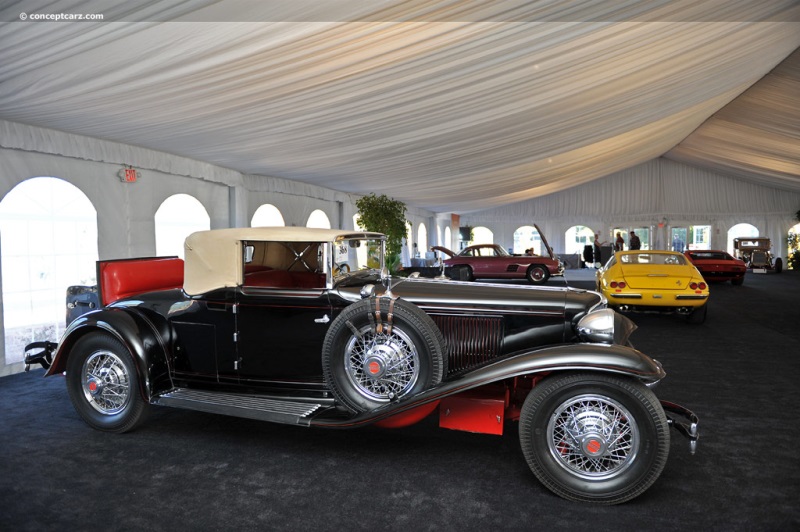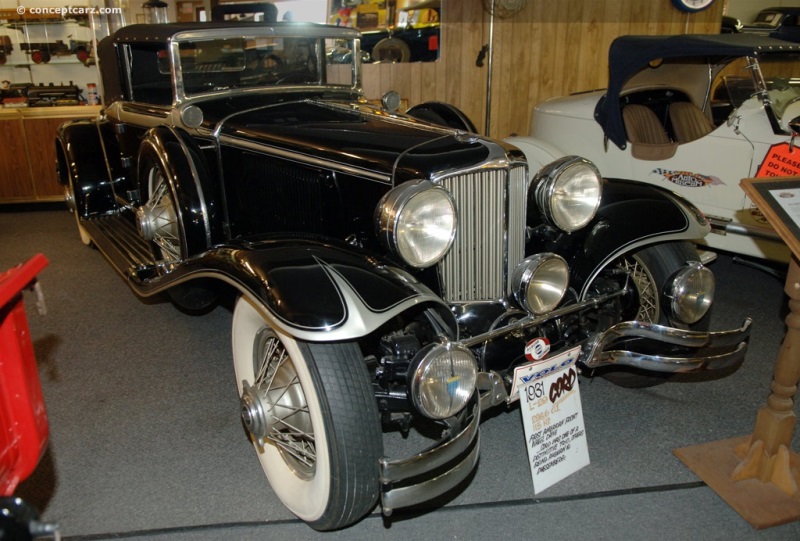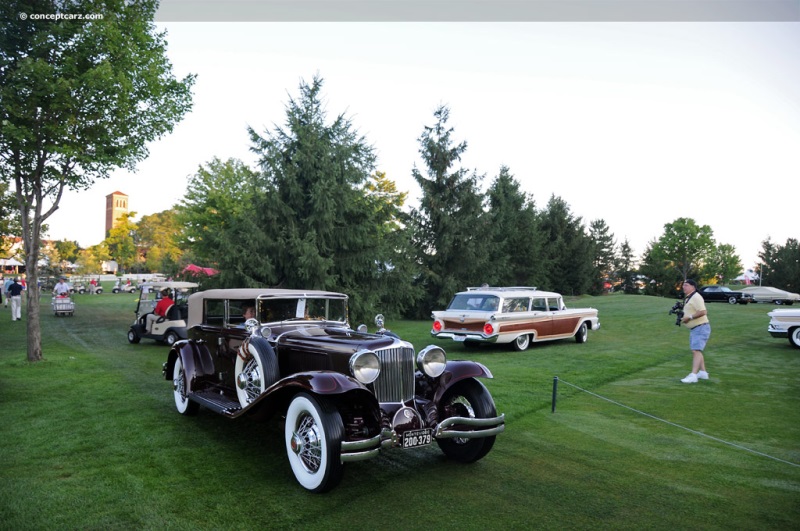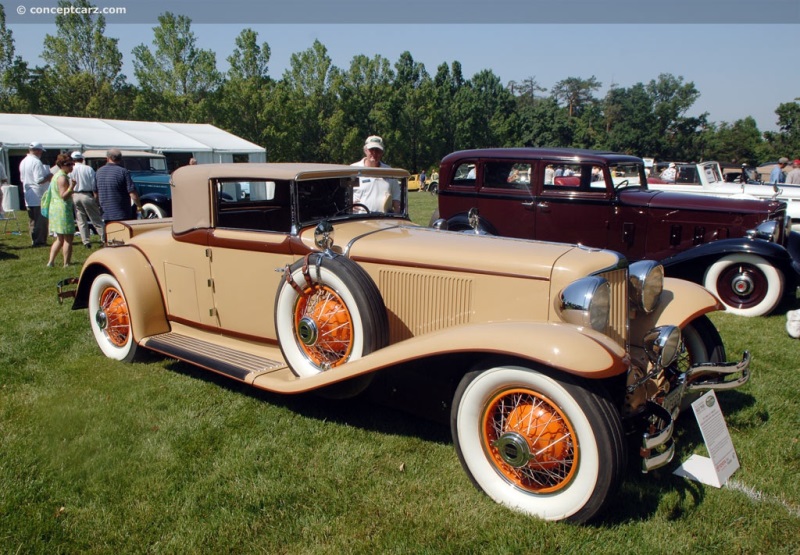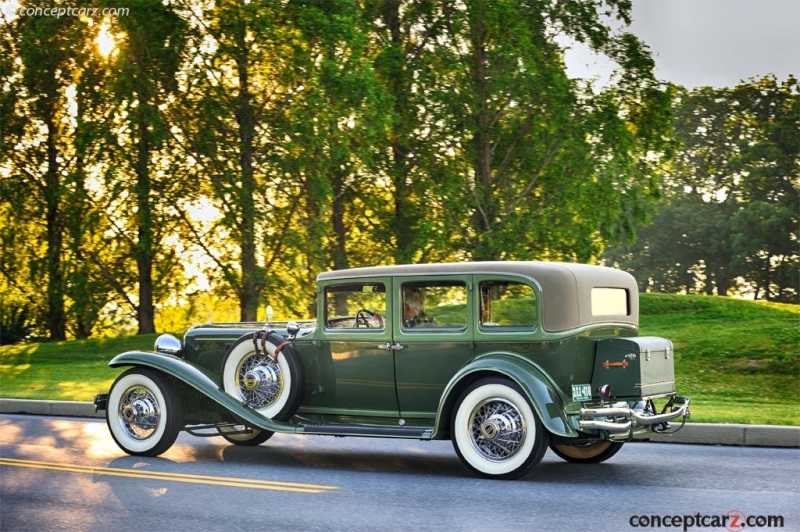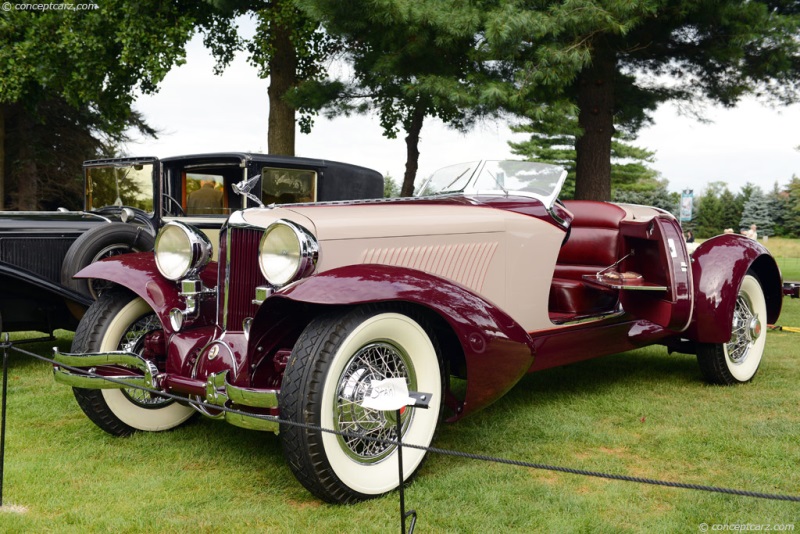The Cord L-29 holds the distinction of being the first major American car to offer front-wheel drive to the public. Introduced during an era of conservatism in automotive engineering coupled with the financial devastation caused by the Great Depression, the existence of the front-wheel drive Cord was brief. They were mechanically genius and stylistically gorgeous, but these two qualities went unnoticed during the Depression in favor of more practical matters. Production of the L-29 began in Auburn in late-1929 and wound up in late-1931 with a token run of 1932 models. Only about 5,000 had been made.
Rumble Seat Cabriolet by Limousine Body Mfg. Co.
View info and historyErrett Lobban Cord
The empire created by Errett Lobban Cord had the Auburn, Cord and Duesenberg marques at its core, and during their brief existence, each made a lasting and dramatic impression. The genesis of the story began with the turnaround of Auburn in the early 1920s by E.L. Cord through effective marketing. The company was struggling to get rid of stodgy-looking inventory when Cord arrived, replacing the somber colors with bright multi-tone paint schemes. By 1926, Cord was the President of the Auburn Automobile Company and soon enlisted one of the best designers in the trade, Al Leamy. Faster and more powerful engines were developed by Lycoming, another company owned by Cord. Within the hierarchy, the Auburn marque offered nearly unprecedented value, and its moderately-priced eight-cylinder lines set a standard for performance, appearance, and value. E.L. Cord acquired the Duesenberg Automobile and Motors Company in 1925, having been impressed by the Duesenberg brothers, August and Fred, skill as master engineers and builders, and their ability to build cars that could surpass any others the world could deliver. Cord's idea was to bring that reputation to market and rival the likes of Bentley, Rolls-Royce, Mercedes-Benz, Hispano-Suiza, Bugatti and many more. E.L. Cord presented Fred Duesenberg with the task of designing and building an entirely new super automobile that could surpass the world's most magnificent automobiles and become 'The Mightiest American Motorcar.' That goal came to fruition on December 1, 1928, when the Model J was introduced to the public.The Cord Corporation
The Cord Corporation was founded by Errett Lobban Cord as a holding company for his numerous (over 150) companies he controlled, mostly in the field of transportation. It was formed on December 28th, 1929, and went defunct on December 23, 1937.
Phaeton Sedan
Chassis #: 2930071
Engine #: FF 4998
View info and history
Auction entries : 1The Cord automobile was intended as a medium-priced car with innovative engineering and distinctive styling. Emulating the dynamic energy of the era, the Cord was a youthful automobile with roomy passenger accommodations, adequate headroom, and a low ride height. Positioned between Auburn and Duesenberg in Cord's product range, the Cord automobile was intended to go head-to-head with Cadillac, Packard, and Pierce-Arrow in the $3,000 - $4,000 price range. Cord L-29
Production of the 'L-29' commenced at the Auburn, Indiana plant in April 1929, with a two-day press launch in June. The first L-29 prototype was completed in late 1928, and Cord was joined on its maiden voyage by chief engineer C.W. Van Ranst and Harry Miller. The competing front-drive Ruxton was announced about a month before Cord's L-29, but Cord beat them to production and to market by several months. The complexity of front-wheel drive and its successful application within a production vehicle that could challenge industry orthodoxy was monumental. Cord reputedly once stated, 'One of my first principles is to be different – not spectacular or contrary, but different.' Front-drive experimentation had occurred much earlier in America through J. Walter Christie's racing cars as early as 1904 and by Harry Miller's highly competitive 1925 FWD Indianapolis 500' car. Cornelius Van Ranst and Tommy Milton further developed the Miller FWD design with their Miller-powered 1927 Indianapolis car. Tested and used in motorsports, the front-drive concept had yet to be applied to a production car. Cord FWD Design and Development
E.L. Cord acquired the rights to Miller's front-wheel drive design to use as the basis for his front-drive production car. The development in road-going guise has been credited to engineer Cornelius Van Ranst, working using some of Indianapolis legend Harry Miller's front-drive patents, and Auburn Chief Engineer Herbert Snow.
Phaeton Sedan
Chassis #: 2930071
Engine #: FF 4998
View info and history
Auction entries : 1The design was simplistic; essentially, it was a rear-wheel drive car with everything tuned around. An early prototype revealed a lack of chassis rigidity and vibrations on uphill turns. These were resolved by adding a central X-member to the 137.5-inch wheelbase chassis (an industry first), and double U-joints on the front axles. The suspension was designed by Van Ranst and based on de Dion ideas, and the brakes were moved inboard, as on the Miller Indy cars. The Lycoming L-head inline 8-cylinder engine was sourced from the Auburn 120 and had a displacement size of 298 cubic inches. The engine was reversed within the engine bay so that the crankshaft exited the block at the front of the car and the flywheel mounted there, driving the three-speed transmission that rested between the front wheels. With the engine mounted backward, special gearing was needed to allow it to be cranked in the normal direction. Accordingly, the three-speed transmission supplied by Detroit Gear required a reversed shift quadrant. Additionally, a long shift lever was needed to control the relocated transmission and extended from the L-29's dashboard down the length of the engine compartment and ended at the gearbox. Styling
Working with chief engineer Thomas Litle, Alan Leamy's automotive design work experience began with Marmon from March 1927 to April 1928. Upon learning of E.L. Cord's stated intention to build a front-drive automobile, Leamy wrote directly to him asking for a position. Cord forwarded the request to Van Ranst, who was impressed with Leamy's design sketches and offered him the position of L-29 chief stylist in August 1928.
Phaeton Sedan
View info and historyThe mechanical complexity of the L-29 was great, but so was the task of creating its coachwork. The long drivetrain package necessitated by the L-29's inline eight-cylinder and front-drive system required Al Leamy to sketch one of the longest hoods ever penned. Modern and youthful, the styling was inspired by European coachwork, similar to those that influenced the designs of General Motors's Harley Earl. Also, like many European top custom coachbuilders of the era, Leamy preferred lighter colors and pastels. The L-29 was offered initially in Sedan, Brougham, Convertible Coupé and Phaeton versions, at prices ranging from $3,095 to $3,295. The design possibilities afforded by the low-slung L-29 chassis attracted several American and European custom coachbuilders, and 43 custom-bodied L-29s were ultimately created. Among the list of coachbuilders were Murphy & Co., Voll & Ruhrbeck, and d'Leteren Freres. Additionally, Brooks Stevens purchased a Speedster new and redesigned the body in the mid-1930s. In total, 5,010 examples of the L-29 were built.La Grande Speedster
Philip O. Wright was a young designer when he presented a boattail speedster design proposal for the Cord L-29 to Auburn President Roy Faulkner. Mr. Wright had been working for the Walter M. Murphy Company in Pasadena and created coachwork for the Duesenberg Model J. The boattail speedster design had a steeply-raked vee'd windshield, aircraft-inspired 'pontoon' fenders, and teardrop-shaped blisters covering the door hinges. After the design gained approval, the coachwork was built by Union City Body Company, part of E.L. Cord's growing industrial complex. The work was completed in time for the New York Auto Salon in late-1931, where it was introduced as the La Grande Speedster. After New York, it was shown in Toronto, Canada, and then at Cord dealerships throughout North America.
Rumble Seat Cabriolet by Limousine Body Mfg. Co.
Chassis #: 2929040
Engine #: FD3696A
View info and history
Auction entries : 1After its North American tour, the La Grande Speedster returned to the factory in Auburn, Indiana for a refresh, with its slim Woodlite headlights, which were illegal in Europe, replaced by standard, round headlights. It then departed for France, where it appeared with actress Suzy Vincent at the Paris Concours d'Elegance and achieved First Place, repeating the success of Count Alexis de Sakhnoffsky and his Hayes-bodied L-29 the prior year. It remained in Europe during World War II, and due to the conflict, its history has been lost to time, and its whereabouts or fate remains a mystery. It remains the only Cord L-29 to receive Philip Wright's La Grande Speedster coachwork.
by Daniel Vaughan | Jan 2024
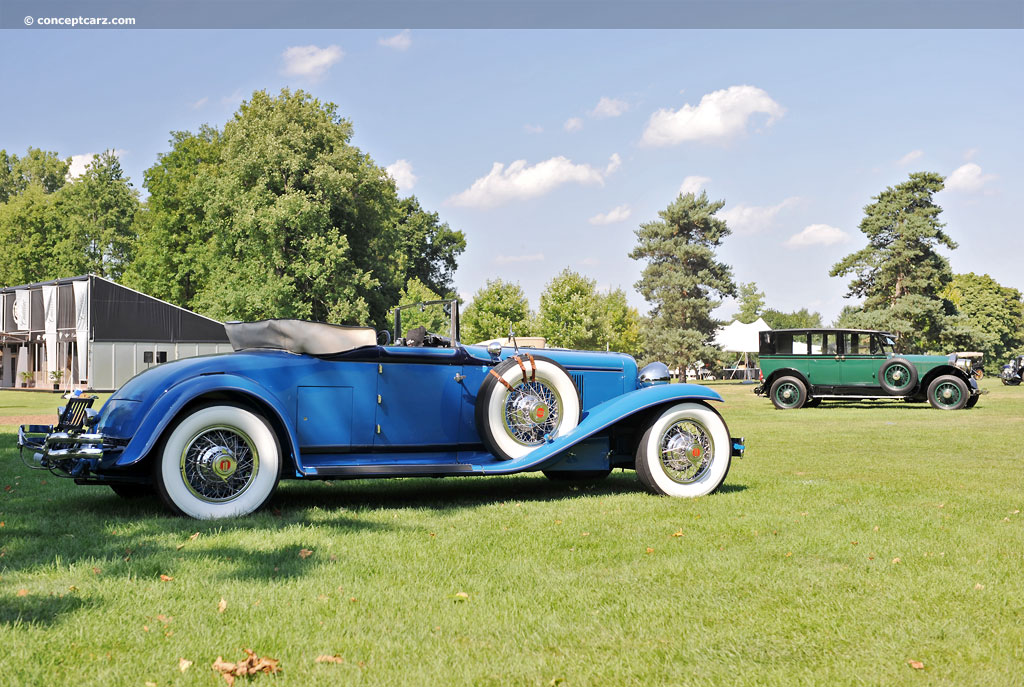
Rumble Seat Cabriolet by Limousine Body Mfg. Co.
View info and history
The empire created by Errett Lobban Cord had the Auburn, Cord and Duesenberg marques at its core, and during their brief existence, each made a lasting and dramatic impression. The genesis of the story began with the turnaround of Auburn in the early 1920s by E.L. Cord through effective marketing. The company was struggling to get rid of stodgy-looking inventory when Cord arrived, replacing the somber colors with bright multi-tone paint schemes. By 1926, Cord was the President of the Auburn Automobile Company and soon enlisted one of the best designers in the trade, Al Leamy. Faster and more powerful engines were developed by Lycoming, another company owned by Cord. Within the hierarchy, the Auburn marque offered nearly unprecedented value, and its moderately-priced eight-cylinder lines set a standard for performance, appearance, and value. E.L. Cord acquired the Duesenberg Automobile and Motors Company in 1925, having been impressed by the Duesenberg brothers, August and Fred, skill as master engineers and builders, and their ability to build cars that could surpass any others the world could deliver. Cord's idea was to bring that reputation to market and rival the likes of Bentley, Rolls-Royce, Mercedes-Benz, Hispano-Suiza, Bugatti and many more. E.L. Cord presented Fred Duesenberg with the task of designing and building an entirely new super automobile that could surpass the world's most magnificent automobiles and become 'The Mightiest American Motorcar.' That goal came to fruition on December 1, 1928, when the Model J was introduced to the public.The Cord Corporation
The Cord Corporation was founded by Errett Lobban Cord as a holding company for his numerous (over 150) companies he controlled, mostly in the field of transportation. It was formed on December 28th, 1929, and went defunct on December 23, 1937.

Phaeton Sedan
Chassis #: 2930071
Engine #: FF 4998
View info and history
Auction entries : 1
Production of the 'L-29' commenced at the Auburn, Indiana plant in April 1929, with a two-day press launch in June. The first L-29 prototype was completed in late 1928, and Cord was joined on its maiden voyage by chief engineer C.W. Van Ranst and Harry Miller. The competing front-drive Ruxton was announced about a month before Cord's L-29, but Cord beat them to production and to market by several months. The complexity of front-wheel drive and its successful application within a production vehicle that could challenge industry orthodoxy was monumental. Cord reputedly once stated, 'One of my first principles is to be different – not spectacular or contrary, but different.' Front-drive experimentation had occurred much earlier in America through J. Walter Christie's racing cars as early as 1904 and by Harry Miller's highly competitive 1925 FWD Indianapolis 500' car. Cornelius Van Ranst and Tommy Milton further developed the Miller FWD design with their Miller-powered 1927 Indianapolis car. Tested and used in motorsports, the front-drive concept had yet to be applied to a production car. Cord FWD Design and Development
E.L. Cord acquired the rights to Miller's front-wheel drive design to use as the basis for his front-drive production car. The development in road-going guise has been credited to engineer Cornelius Van Ranst, working using some of Indianapolis legend Harry Miller's front-drive patents, and Auburn Chief Engineer Herbert Snow.
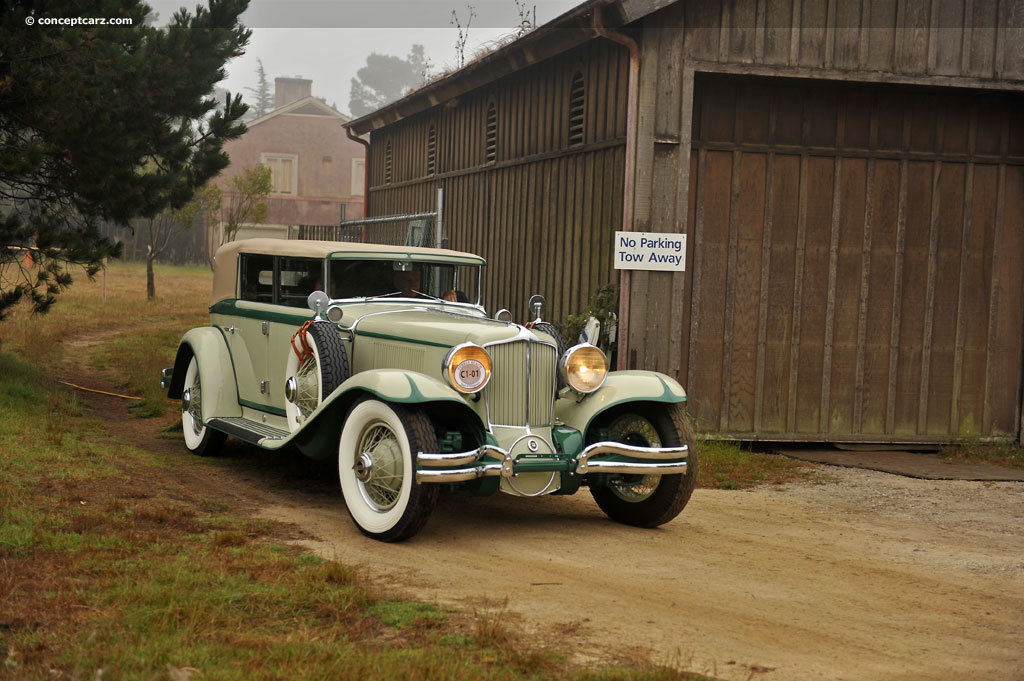
Phaeton Sedan
Chassis #: 2930071
Engine #: FF 4998
View info and history
Auction entries : 1
Working with chief engineer Thomas Litle, Alan Leamy's automotive design work experience began with Marmon from March 1927 to April 1928. Upon learning of E.L. Cord's stated intention to build a front-drive automobile, Leamy wrote directly to him asking for a position. Cord forwarded the request to Van Ranst, who was impressed with Leamy's design sketches and offered him the position of L-29 chief stylist in August 1928.
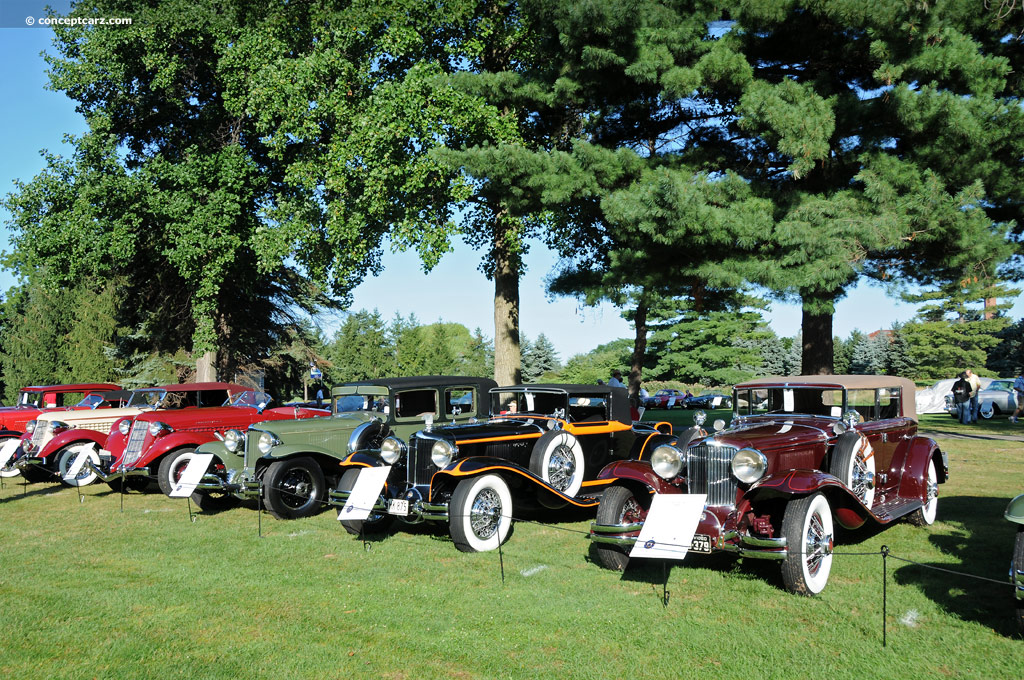
Phaeton Sedan
View info and history
Philip O. Wright was a young designer when he presented a boattail speedster design proposal for the Cord L-29 to Auburn President Roy Faulkner. Mr. Wright had been working for the Walter M. Murphy Company in Pasadena and created coachwork for the Duesenberg Model J. The boattail speedster design had a steeply-raked vee'd windshield, aircraft-inspired 'pontoon' fenders, and teardrop-shaped blisters covering the door hinges. After the design gained approval, the coachwork was built by Union City Body Company, part of E.L. Cord's growing industrial complex. The work was completed in time for the New York Auto Salon in late-1931, where it was introduced as the La Grande Speedster. After New York, it was shown in Toronto, Canada, and then at Cord dealerships throughout North America.
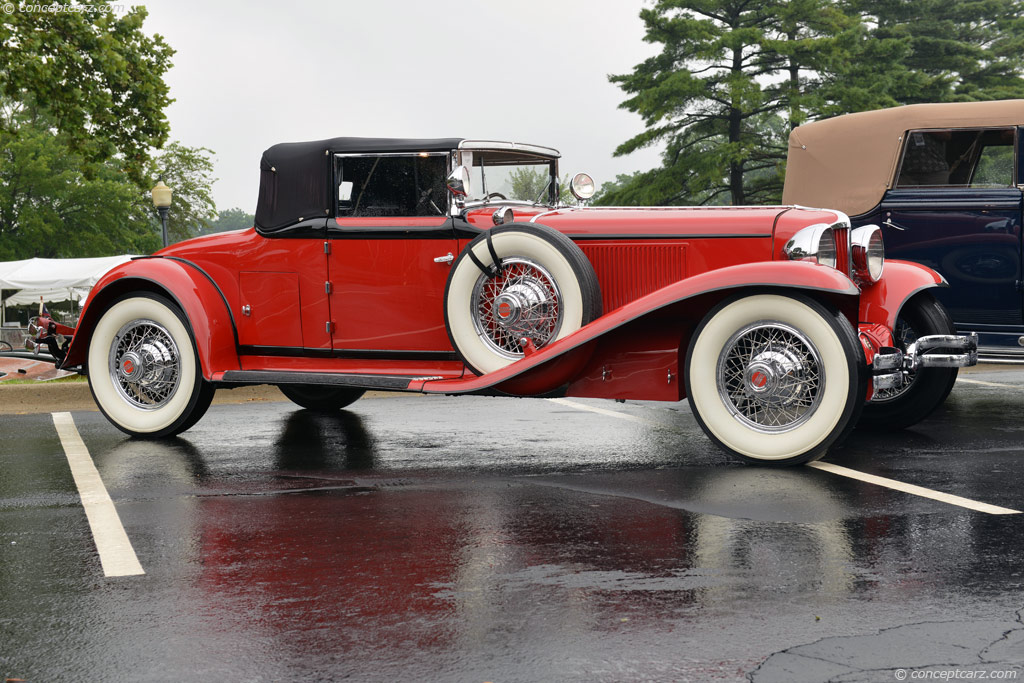
Rumble Seat Cabriolet by Limousine Body Mfg. Co.
Chassis #: 2929040
Engine #: FD3696A
View info and history
Auction entries : 1
by Daniel Vaughan | Jan 2024
Related Reading : Cord L-29 History
The Cord L-29 was revolutionary, using a front-wheel drive system rather than the popular rear-wheel drive configuration. Many believed that having the front wheels be responsible for turning, carrying the bulk of the weight, providing stopping power, and driving was too much. With the rear-wheel drive systems, the weight could be dispersed throughout the body to take advantage of weight distribution.....
Continue Reading >>
Continue Reading >>
1931 Cord L-29 Vehicle Profiles
Recent Vehicle Additions
Performance and Specification Comparison
Price Comparison
L-29 Specification Comparison by Year
Year
Production
Wheelbase
Engine
Prices
Related Automotive News

The First-Ever AAR Gurney Eagle, Accompanied by Roster of American Automotive All-Stars, Announced for Gooding & Company's Amelia Island Auctions
The auction house is offering the very first AAR Gurney Eagle Mk 1 at its upcoming Amelia Island Auctions, as well as a 1931 Duesenberg Model J Convertible Sedan, a 1935 Auburn 851 SC Boattail Speedster, and other select American icons.
Gooding...

RM Sotheby's to Present The Guyton Collection Entirely Without Reserve
60 AUTOMOBILES AND HUNDREDS OF AUTOMOBILIA LOTS SET FOR 4-5 MAY SALE
RM Sothebys offers the respected Guyton Collection, entirely without reserve, 4-5 May in St. Louis, Missouri
Superbly curated collection comprises rarest of Veteran, Br...

The World's Best Packard: Pebble Beach Best Of Show-Winning 1934 Packard Set For RM Sotheby's Monterey Stage
RM Sothebys announces two Pebble Beach award-winning cars from collection of Judge Joseph and Margie Cassini for flagship Monterey sale, 24-25 August
1934 Packard Twelve Individual Custom Convertible Victoria by Dietrich returns to Monterey Peni...

Auburn Is 'The Amelia's' Honored Classic In 2018
Auburns fabled boattail speedster is the car everyone pictures when the classic Indiana marque is mentioned. Only in the Jazz Age lubricated by the social privations of the Eighteenth Amendment could such an exquisitely and outrageously shaped automobile...

RM Auctions Amelia Island Preview - 2014
0
RM Auctions, the worlds largest auction house for investment-quality automobiles, will hold its Amelia Island, Florida, sale on March 8th at the Ritz-Carlton.
As the official auction house of the Amelia Island Concours dElegance, RMs...






























